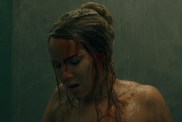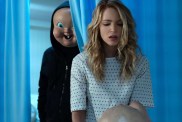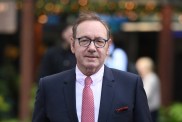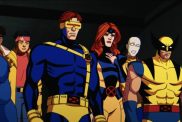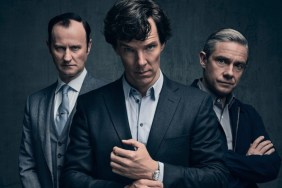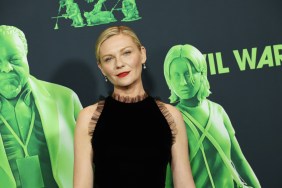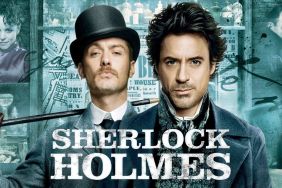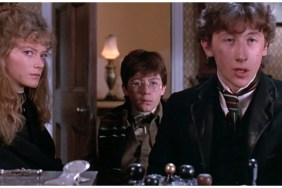
Last November, ComingSoon.net happened to be in London when we received a surprise Email from Warner Bros. with a last-minute invite to visit the secret location where Guy Ritchie was filming his latest movie, a reinvention of Sir Arthur Conan Doyle’s literary figure Sherlock Holmes. Having interviewed Ritchie twice in the past year, we knew all about this project and the idea of having a chance to see Robert Downey Jr. and Jude Law–Holmes and Dr. Watson, respectively–quite literally in action, was too great an opportunity to pass up, even if it meant returning home a day later then planned.
Being in London, it was fairly obvious how much more interest there was in what Ritchie and his cast were going to do with Doyle’s character. After all, England is the birthplace of Holmes, who has continued to remain popular there even without any sort of regular film or television output in recent years. Ever since the first pictures of Downey Jr. and Law as their characters turned up, there’s been many questions and concerns whether Ritchie, a well-regarded cinematic stylist, and Downey Jr., an American (!), might be able to do the material justice. There’s also the fact that Jude Law is not exactly the pudgy sidekick as Dr. Watson has been commonly depicted in the past. The chance to get a taste for what they were planning certainly whet our ravenous appetites as well as getting a rare chance to talk to the two actors in the midst of the process. (For those who just can’t wait to get to the interview with Downey Jr. and Law at the end of our piece, you can jump to it right here.)
For those unfamiliar with the original source material, Sir Arthur’s character first appeared in the late 19th Century as the lead in a number of short stories and a handful of mystery novels, but the character has been kept alive via a series of movies and television going back to the early days of both media, the most famous film version played by Basil Rathbone and the most recent television version being played by Jeremy Brett. Guy Ritchie’s version of the character is loosely based on an unpublished graphic novel by the film’s producer, Lionel Wigram, and it’s set in London 1891 after Holmes and Watson had been together for eight or ten years solving murders and other cases. There were a few conflicting comments during our visit whether or not it could be deemed an “origin story,” but the film shows one of the duo’s biggest and most important cases, one that involves black magic and has implications for the entire world.
With all of those expectations swirling around in our heads, a small group of journalists were driven out to East London to The Priory Church of Saint Bartholomew the Great, where the production had been shooting for three days. “St. Bart’s” is one of the oldest parish churches in London, founded back in the 12th Century, and while on a normal day, it would be open to the general public for sightseeing or prayer services, they were actually filming inside.
The space itself was pretty amazing–you can see pictures at the link above–and they had cleared out all the pews from the main hall, just keeping the space’s ancient architecture and replacing the interiors with all the makings of a crypt, an altar in the center of the space being the most prominent construct with a lavish sculpture beneath it and two flaming pyres at its head. The entire floor was covered in fake dirt with three or four fake pillar constructs around it to create the illusion of it being the underground catacombs of St. Paul’s Cathedral. The altar of the church had been turned into a makeshift mausoleum with a large sculpted cross and two praying angels as well as a few scattered gravestones.
Outside of the shooting area, we would see all sorts of plaques and memorials from the 16th Century and earlier, giving us an impression of how old the place was and how much history had taken place inside. The atmosphere in the space was quite exhilarating, creating the general mood of being transported back a hundred years to old London, and it was impressive how little was required to transform the place so dramatically. Kudos would be well deserved by Sarah Greenwood, the Oscar-nominated production designer who had worked on many British period films like Pride & Prejudice and Atonement. Later, we’d have a chance to kill some time talking to Philip Stewart, the local professional who knew everything about St. Bart’s, who filled us in on some of the productions that filmed inside the cathedral’s enormous hall, including period dramas such as The Other Boleyn Girl and Elizabeth: The Golden Age.

As we arrived, they were shooting the opening scene of the movie where Holmes and Watson are following the film’s main villain Blackwood, a reputable businessman played by Mark Strong who is involved with criminal activities, as well as a little black magic. They’ve been hired by the family of a young girl to find her, and when they do, she’s in the catacombs of St. Paul’s being sacrificed by Blackwood. As Holmes and Watson watch from the shadows as he stands over a prone woman lying on an altar, reciting incantations and holding a dagger above her ready to sacrifice her. She was spasming and writhing on the altar like Linda Blair as Blackwood read mystical incantations. We were surprised that it wasn’t Mark Strong, whom some might remember from Ritchie’s last movie RocknRolla, hovering over the helpless girl but a convincing stand-in. The scene was shot from a number of angles including an amazing crane shot that began close-up on the girl’s face then panned up and away.
After they finished that set-up, they moved onto the next scene where Holmes and Watson burst in to face Blackwood’s thugs dressed in gray suits and bowler hats, taking two of them down before a third one walks in from the direction of the altar with a gun. At first the fight sequence was being set-up using Downey and Law’s stand-ins with someone on set shouting “Bang! Bang!” to emulate the gunshots. The gunned goon is taken down in short order by Watson, who picks up the gun and points it at Blackwood, saying to Holmes, “After you.”
We were all taken aback when we realized that Downey and Law had replaced their stand-ins so seamlessly we weren’t even sure it was them. Especially surprising was how unrecognizable Law was as Dr. Watson, merely by giving him a moustache and sideburns, but he also looked fierce and intense while fighting, compared to Downey, who seemed a little more laid back about being in danger. There’s not a lot to say about the fight scene except that the two men used a combination of boxing and martial arts with Downey wielding two single sticks as his weapon and Watson using his cane. We watched the duo fight the goons over and over again from a lot of different angles and camera contraptions to create Ritchie’s distinctive visuals. Towards the end, they were doing extreme close-ups of the two actors fighting using handheld cameras, and one can expect that Ritchie will find a way to cut together all of these disparate shots to create something true to his trademark filmmaking style.
Ritchie himself was sequestered away in his own private viewing area, wearing a grey Dunhill suit with an acoustic guitar nearby that he’d pick up and strum from time to time. Sadly, we wouldn’t have a chance to talk to him while on location, though it wasn’t too surprising considering all the stuff being written in the tabloids at the time about his messy divorce with a certain pop singer. From our distanced perspective, he seemed to be taking it well by throwing himself into his work, and filming a fight sequence seemed to be doing him good.
After watching them shoot for a short time, we were taken into a quiet alcove at the side of the church for a sit-down with producers Susan Downey and Lionel Wigram, the latter being the one who originated the project at Warner Bros. before Susan Downey got involved with Joel Silver’s production company. (The other producers on the film are Steve Clark-Hall, who co-produced Ritchie’s last two movies, and the ultra-cool Dan Lin, who is also producing Terminator Salvation and Ricky Gervais’ Invention of Lying, two movies we’re really looking forward to seeing.) We spoke to them for nearly 40 minutes, taking a few “quiet breaks” as they began rolling tape in the adjoining room with a loud gunshot signifying the end of each take.
“I’d been a fan of Sherlock Holmes for years and years, all my life since I was a kid,” Wigram told us about the origins of the character. “I was an executive at Warner Bros. and when I became a producer, the first thing I decided to do was do Sherlock Holmes. I’d always felt when I read the original stories that somehow the images that I had in my head of Sherlock Holmes were different than anything I’d seen in a movie. To me, he was a much more Bohemian character, he’s a much more modern character than the Basil Rathbone based character that we’ve seen in all the TV stuff. Much I love the TV and ‘Masterpiece Theater’ stuff, the Jeremy Brett stuff, it felt like there was a lot more to be done. Sherlock Holmes in the Conan Doyle is a man who is quite happy to spend two weeks lying on his sofa doing nothing between cases. He’s a man who does do bare-knuckle fighting and goes down to the East End and fights when he’s not on a case, just to clear his head. He’s a man who has killed Moriarty using baritsu, which is a form of ju-jitsu. He’s a man of action and I felt a very modern character that kids of today could really relate to, both as a misfit and as a man who goes his own way.”

Clearly an expert on the character, Wigram continued to talk about why he had immediate appeal to the execs at Warner Bros.: “What actually happened was that, as you know, Hollywood movies at this point are always looking for ways to do branded materials. Big titles, that’s the name of the game. That’s just the reality we all live in, so we thought, ‘This is an amazing title.’ Sherlock Holmes has been popular for a hundred years, and anywhere you go in the world, people have heard of Sherlock Holmes. They know he’s the greatest detective in the world. They might not know the exact details, they may have seen something on TV, they may have never read a book, but they know about Sherlock Holmes, they know about Watson.”
“It has like a 98% name recognition or something like that,” Downey agreed. “There’s a huge percentage of people who actually believe he’s a real character.”
Wigram jumped back in: “Rereading all the stories, it was clear that the stories are very clever murder mysteries, there’s wonderful stuff in them, but they didn’t quite have the scale and scope that a big Hollywood event movie needs, so I thought it would be interesting if I could come up with a story that would be true to the books, true to the times, but also would have that sort of scale? The first thing was to make sure that a lot of the action that Conan Doyle refers to was actually made manifest in our film. Very often, Sherlock Holmes will say things like, ‘If I hadn’t been such an expert short stick person, I would have died in that’ or he would refer to a fight off screen. We’re putting those fights on screen. One of the big inspirations for this was that Victorians, including Conan Doyle, were obsessed with spiritualism and the occult and all that kind of stuff. One of the big cult figures of the Victorian era or slightly later was Aleister Crowley. He was known as ‘The Beast’ and he was part of a group called the Golden Dawn, and they believed they could raise spirits and angels and demons and stuff like that and get them to do stuff. His influence on pop culture has been really huge. I thought wouldn’t it be interesting to bring a character like that into the world of a man who purports to have supernatural powers and it felt very relevant to Victorian times.”
“I basically wrote that story out and then I felt like for the studio to really understand and get what we were doing and get their heads out of that idea in the Deerstalker with a pipe, you needed some sort of visual inspiration, so I hired this wonderful comic book artist called John Watkiss to basically illustrate my story and we produced a small 25 page comic book, and we basically drew Sherlock Holmes. He looked a bit of a mess, he had stubble, he had a pistol in one hand and a sword in the other, and he was fighting and doing cool stuff. I think it was the images, as much as anything. I took it to Dan Lin, who was an executive at the time, and said, ‘Look at the picture’ and he said, ‘I get that.’ That was sort of the reaction, which was very exciting and then Warner Bros. basically bought that from me and paid for a writer to come on board and do a draft, then we went and did the usual development process where we did a couple drafts and got to the point where everybody felt it was it was a pretty cool movie. There started to be interest and at that point, Guy Ritchie read it and it was one of those things where looking for the definition of what this movie was and how it was going to be different and how it was going to be presented in a different way, I always saw it in my mind, having been a big fan of ‘Lock Stock’ and ‘Snatch’ and all that, as the Guy Ritchie version of Sherlock Holmes. I would describe it that way, and through circuitous and serendipitous means, it ended up being the Guy Ritchie version literally, which is fantastic.”
We’re pretty sure that Lionel could talk all day about Sherlock Holmes if given the chance, but that should give you some idea how this project got rolling. (Apologies to Susan Downey, though maybe we’ll have a chance to run the rest of our interview at a later time.) Neither one of them would confirm nor deny whether we might have a chance to see the most famous Holmesian villain Moriarty in this film, something that’s been on a lot of minds for the past few months.
Later, we were guided down the street, walking through the Smithfields meat market to a place called The Farmiloe Building, which looked at first like any other London storefront on the street, but once we got inside and were taken up the stairs, we found out that there was another building in the back which was essentially a giant empty warehouse where a lot of productions have been filmed, including Christopher Nolan’s Batman Begins. Upstairs, they had set-up a makeshift cafeteria where most of the crew were having a quick spot of lunch, but they also had set-up production offices and wardrobe departments for the film. We were told that they had actually shot an earlier scene in this location, when it had been made-up like an slaughterhouse, where the duo end up while they’re chasing Blackwood.

After we got back to the church, Joel Silver and Guy’s production partner Lauren came over with a laptop to show us a scene they’d shot just a week prior, but had already roughly edited together. The clip started with Holmes sitting in a restaurant eating at a table in a way that was almost reminiscent of his take on Charlie Chaplin in the famous shoe-eating scene in the biopic for which Downey received a well-earned Oscar nod. As Holmes eats, he thinks back to a recent fight he had, a bare-knuckle boxing match which had been filmed elsewhere. Holmes is taking on a much larger bruiser, and the detective is clearly out-matched as we see him getting pummeled, coming to an end with an uppercut that sends him reeling to the ground in slow motion, reminiscent of a similar scene involving Brad Pitt in Snatch. During this brutal and thankfully short-lived fight, we get our first glimpse of Rachel McAdams as Irene Adler, Holmes’ love interest in the film. After getting trounced, Holmes gets up and starts walking away saying, “We’re done, Big Man,” but his opponent is having none of that. “We’re not done!” he growls stopping Holmes in his tracks. In his head, Holmes starts formulating a strategy to take down his larger enemy, a complex and scientific method and his thoughts narrate this scenario as he claps the larger man in the ears, throws dirt in his face to blind him and punches him repeatedly in the face before kicking the man back through a wooden gate at the end of the make-shift ring. Holmes muses that this strategy would cause his opponent “six weeks of physical recovery, six months of psychological damage.” The camera cuts back to Holmes still thinking about what he’s going to do, and sure enough, he turns around and does exactly what he had just suggested with the exact same results of taking the man down. Holmes then walks out of the ring, grabbing papers (possibly money) from a man waiting outside the ring.
For something that was thrown together fairly quickly with a temp song as its score, it was impressive and definitely in line with some of Ritchie’s better work in look and feel, yet clearly bringing the creativity in character development that Downey Jr. might bring to the role. We were so impressed we even suggested to Silver that it might make a great clip to present at Comic-Con this year.
Afterwards, we had a chance to sit down in an area at the back of the church with producer Joel Silver to get his own take and interest in the production, which you can read at the link below:
After watching them filming the fight sequence for a little while longer, we had a chance to sit down with Robert Downey Jr. and Jude Law for a fast-paced 15 minutes of back-and-forth as the two actors who had been energized by all the fighting used that energy to field questions. You can read that interview by clicking on the link below:
Interview with Robert Downey Jr. and Jude Law
Now this might sound odd considering the duo we had a chance to speak to, but personally, I was even more excited about this visit when I saw Eddie Marsan’s name in the notes handed out to us as we arrived at Bartholomew’s, because I have been a fan of the actor’s work since seeing him in Mike Leigh’s Vera Drake in which he played the title character’s bashful son-in-law Reg. It was a real thrill to learn that I’d finally have a chance to meet the actor who rarely does press in the United States, though he’d been starring in more prominent roles in recent years, such as playing the villain in Will Smith’s Hancock and playing the cranky driving instructor Scott in Leigh’s Happy-Go-Lucky. In Sherlock Holmes, Marsan plays Chief Inspector Lestrade of Scotland Yard, who actually comes straight out of Doyle’s original stories. Marsan described his character as the antithesis of Holmes, a detective who isn’t quite as brilliant as Holmes giving him an inferiority complex which infuriates him. We had a really fun interview with Marsan, but sadly, due to time constraints, we’re going to have to save it, though CS readers will have a chance to read it sometime in the coming weeks.
Guy Ritchie’s Sherlock Holmes is scheduled to open on Christmas Day.
